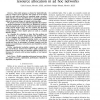Free Online Productivity Tools
i2Speak
i2Symbol
i2OCR
iTex2Img
iWeb2Print
iWeb2Shot
i2Type
iPdf2Split
iPdf2Merge
i2Bopomofo
i2Arabic
i2Style
i2Image
i2PDF
iLatex2Rtf
Sci2ools
TMC
2008
2008
A Bidding Algorithm for Optimized Utility-Based Resource Allocation in Ad Hoc Networks
Abstract-- This article proposes a scheme for bandwidth allocation in wireless ad hoc networks. The quality of service (QoS) levels for each end-to-end flow are expressed using a resourceutility function, and our algorithms aim to maximize aggregated utility. The shared channel is modeled as a bandwidth resource defined by maximal cliques of mutual interfering links. We propose a novel resource allocation algorithm that employs an auction mechanism in which flows are bidding for resources. The bids depend both on the flow's utility function and the intrinsically derived shadow prices. We then combine the admission control scheme with a utility-aware on-demand shortest path routing algorithm where shadow prices are used as a natural distance metric. As a baseline for evaluation we show that the problem can be formulated as a linear programming (LP) problem. Thus, we can compare the performance of our distributed scheme to the centralized LP solution, registering results very close ...
| Added | 15 Dec 2010 |
| Updated | 15 Dec 2010 |
| Type | Journal |
| Year | 2008 |
| Where | TMC |
| Authors | Calin Curescu, Simin Nadjm-Tehrani |
Comments (0)

